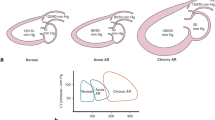Abstract
Thoracic endovascular aortic repair is widely used for type B aortic dissection. However, there is no favorable stent-graft for type A aortic dissection. A significant limitation for device development is the lack of an experimental model for type A aortic dissection. We developed a novel three-dimensional biomodel of type A aortic dissection for endovascular interventions. Based on Digital Imaging and Communication in Medicine data from the computed tomography image of a patient with a type A aortic dissection, a three-dimensional biomodel with a true lumen, a false lumen, and an entry tear located at the ascending aorta was created using laser stereolithography and subsequent vacuum casting. The biomodel was connected to a pulsatile mock circuit. We conducted four tests: an endurance test for clinical hemodynamics, wire insertion into the biomodel, rapid pacing, and simulation of stent-graft placement. The biomodel successfully simulated clinical hemodynamics; the target blood pressure and cardiac output were achieved. The guidewire crossed both true and false lumens via the entry tear. The pressure and flow dropped upon rapid pacing and recovered after it was stopped. This simulation biomodel detected decreased false luminal flow by stent-graft placement and detected residual leak. The three-dimensional biomodel of type A aortic dissection with a pulsatile mock circuit achieved target clinical hemodynamics, demonstrated feasibility for future use during the simulated endovascular procedure, and evaluated changes in the hemodynamics.




Similar content being viewed by others
References
Fattori R, Montgomery D, Lovato L, et al. Survival after endovascular therapy in patients with type B aortic dissection: a report from the international registry of acute aortic dissection (IRAD). JACC Cardiovasc Interv. 2013;6:876–82.
Arakawa M, Okamura H, Miyagawa A, et al. Clinical outcome of acute thoracic aortic syndrome in nonagenarians. Asian Cardiovasc Thorac Ann. 2020;28:577–82.
Evangelista A, Isselbacher EM, Bossone E, et al. Insights from the international registry of acute aortic dissection: a 20 year experience of collaborative clinical research. Circulation. 2018;24:1846–60.
Nienaber CA, Sakalihasan N, Clough RE, et al. Thoracic endovascular aortic repair (TEVAR) in proximal (type A) aortic dissection: ready for a broader application? J Thorac Cardiovasc Surg. 2017;153:S3–11.
Harky A, Chan J, MacCarthy-Ofosu B. The future of stenting in patients with type A aortic dissection: a systematic review. J Int Med Res. 2020. https://doi.org/10.1177/0300060519871372.
Boufi M, Claudel M, Dona B, et al. Endovascular creation and validation of acute in vivo animal model for type A aortic dissection. J Surg Res. 2018;225:21–8.
Tam CHA, Chan YC, Law Y, Cheng SWK. The role of three-dimensional printing in contemporary vascular and endovascular surgery: a systematic review. Ann Vasc Surg. 2018;53:243–54.
Schmauss D, Juchem G, Weber S, et al. Three-dimensional printing for perioperative planning of complex aortic arch surgery. Ann Thorac Surg. 2014;97:2160–3.
Shiraishi I, Yamagishi M, Hamaoka K, et al. Simulative operation on congenital heart disease using rubber-like urethane stereolithographic biomodels based on 3D datasets of multislice computed tomography. Eur J Cardiothorac Surg. 2010;37:302–6.
Liu C, Chen D, Bluemke DA, et al. Evolution of aortic wall thickness and stiffness with atherosclerosis: long-term follow up from the multi-ethnic study of atherosclerosis (MESA). Hypertension. 2015;65:1015–9.
Sumikura H, Homma A, Ohnuma K, et al. Development and evaluation of endurance test system for ventricular assist devices. J Artif Organs. 2013;16:138–48.
Gottardi R, Mudge T, Czerny M, et al. A truly non-occlusive stent-graft moulding balloon for thoracic endovascular aortic repair. Interact Cardiovasc Thorac Surg. 2019;29:352–4.
Erbel R, Aboyans V, Boileau C, et al. ESC Guidelines on the diagnosis and treatment of aortic diseases: document covering acute and chronic aortic diseases of the thoracic and abdominal aorta of the adult. The task force for the diagnosis and treatment of aortic diseases of the European Society of Cardiology (ESC). Eur Heart J. 2014;35:2873–926.
Baikoussis NG, Antonopoulos CN, Papakonstantinou NA, et al. Endovascular stent grafting for ascending aorta diseases. J Vasc Surg. 2017;66:1587–601.
Shah A, Khoynezhad A. Thoracic endovascular repair for acute type A aortic dissection: operative technique. Ann Cardiothorac Surg. 2016;5:389–96.
Chassin-Trubert L, Ozdemir BA, Roussel A, et al. Prevention of retrograde ascending aortic dissection by cardiac pacing during hybrid surgery for zone 0 aortic arch repair. Ann Vasc Surg. 2020. https://doi.org/10.1016/j.avsg.2020.08.136 (Online ahead of print).
Burris SN, Nordsletten DA, Sotelo JA, et al. False lumen ejection fraction predicts growth in type B aortic dissection: preliminary results. Eur J Cardiothorac Surg. 2020;57:896–903.
Morimont P, Lambermont B, Desaive T, et al. Arterial dP/dtmax accurately reflects left ventricular contractility during shock when adequate vascular filling is achieved. BMC Cardiovasc Disord. 2012;12:13.
Fujimura N, Kawaguchi S, Obara H, et al. Anatomic feasibility of next-generation stent grafts for the management of type A Aortic dissection in Japanese patients. Circ J. 2017;25:1388–94.
Acknowledgements
We would like to thank Editage (www.editage.com) for English language editing. This work was supported by JSPS KAKENHI Grant Number JP 21K16501.
Author information
Authors and Affiliations
Contributions
MA, HS and AM carried out the experiment. MA wrote the manuscript with support from HO. AH and AY supervised the project.
Corresponding authors
Ethics declarations
Conflict of interest
The authors declare no conflicts of interest.
Additional information
Publisher's Note
Springer Nature remains neutral with regard to jurisdictional claims in published maps and institutional affiliations.
Supplementary Information
Below is the link to the electronic supplementary material.
Supplementary file2 (MPG 165508 kb)
Rights and permissions
About this article
Cite this article
Arakawa, M., Sumikura, H., Okamura, H. et al. A three-dimensional biomodel of type A aortic dissection for endovascular interventions. J Artif Organs 25, 125–131 (2022). https://doi.org/10.1007/s10047-021-01294-0
Received:
Accepted:
Published:
Issue Date:
DOI: https://doi.org/10.1007/s10047-021-01294-0




